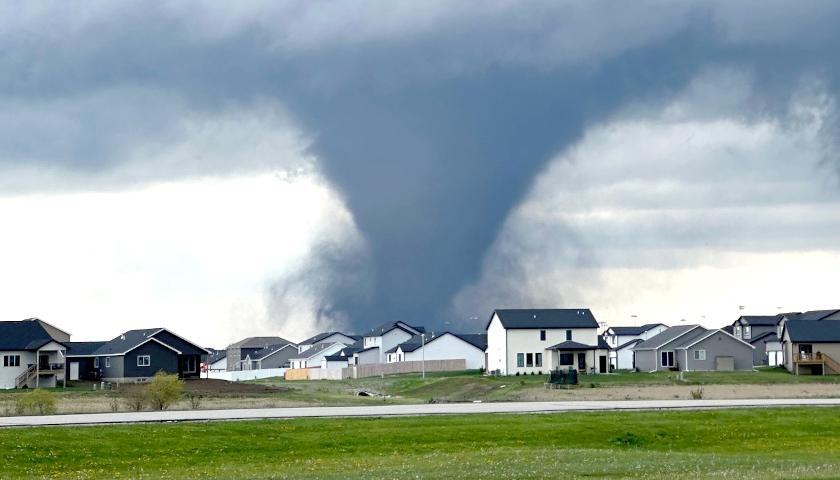by Kevin Killough
Homeowners across the U.S. are seeing skyrocketing insurance rates, increased deductibles, excluded protections, and canceled policies.
Insurers say that they’re having to adjust to changing conditions to remain profitable. Among the problems they blame is inflation, rising construction costs, and costs associated with regulatory compliance. But many insurers are also blaming climate change for driving extreme weather events and increasing losses, and much of the media coverage is zooming in on this narrative.
However, the data on weather trends shows little evidence that the frequency or intensity of storms are increasing, and critics say it’s a symptom of a much larger issue with a lack of skepticism and curiosity in climate reporting.
“Journalists aren’t equipped to go into the studies. They’re not economists. They’re not climate scientists. They’re journalists,” Ryan Maue, a research meteorologist told Just the News. “They’re supposed to ask questions and dig deeper by going to ask all the sources, or go find experts either to talk on the record or off the record. And for whatever reason, this field just does not do that.”
Climate shocks
The Washington Post reported in September that Allstate, American Family, Nationwide, Erie Insurance Group and Berkshire Hathaway told regulators that “extreme weather patterns caused by climate change” led them to stop insurance people in some regions, exclude protections for some types of weather events, and raise monthly premiums and deductibles.
The Financial Times reported in April that “Home insurance is becoming increasingly unaffordable in areas such as California and Australia, as global warming has made storms, floods and wildfires more frequent and severe.”
The New York Times Monday ran another such report, claiming that the insurers are bleeding cash from “climate shocks.”
“The insurance turmoil caused by climate change — which had been concentrated in Florida, California and Louisiana — is fast becoming a contagion, spreading to states like Iowa, Arkansas, Ohio, Utah and Washington,” Times reporters Christopher Flavelle and Mira Rojanasakul wrote.
The Times reporters claimed, without any attribution to any data source, that “as a warming planet makes events like hail and wind storms worse, insurers are fleeing.”
Dr. Roger Pielke Jr., professor of environmental studies at the University of Colorado at Boulder, graphed the trends on hail and wind reports between 2010 and 2023 using data from the National Oceanic and Atmospheric Administration’s Storm Prediction Center (SPC). Neither set of data showed any worsening trends over the time period.
“Why is the climate beat so allergic to actual data when making claims about data?” Pielke asked in the post on X where he shared the data.
Just the News reached out to Flavelle and Rojanasakul to ask if they had sought out this data, were aware it exists, or why it was excluded if they are aware of it. Neither reporter responded to questions for this story.
Chris Martz, a metrology student in the Millersville University meteorology program, dove deeper into NOAA’s SPC data, as well as the AR6 report of the United Nations Intergovernmental Panel on Climate Change, a consortium of the world’s leading climate scientists.
According to Chapter 11 of the report, which deals with extreme weather trends, no trends in hail have been observed, and therefore, no signal from climate change can be attributed to this type of event.
“In the USA, it is indicated that there is no significant increase in convective storms, and hail and severe thunderstorms,” Section 7.3.2 of the chapter explains. It goes on to explain that trends are difficult to validate due to the lack of quality data, so any trends positive or negative are uncertain.
The SPC data from NOAA, Martz shows in the post on X, also shows no increases in the frequency or intensity of tornadoes, either.
To demonstrate trends in increasing frequency and severity of storms, the Times article relies primarily on trends in disaster costs over time, as shown in NOAA’s “Billion Dollar Disaster” tally, which is adjusted only for inflation.
Pielke published a peer-reviewed article on a number of problems with the methodology that NOAA uses in its tally. Among many issues Pielke points out is that the tally doesn’t normalize disaster costs. As Pielke explains on his “The Honest Broker“ Substack, as development in an area increases, more development is impacted by storms. This will increase disaster costs over time independent of any trends in frequency or severity of storms. To adjust for these differences, researchers have to normalize disaster costs to get accurate information on trends.
Pielke has been researching trends in normalized costs of disasters for decades, and his research consistently finds no increases. Disaster costs, he says, are a terrible metric for examining trends in climate events. For those trends, Pielke says you have to look at climate data.
Misinformation
On his X account, Maue has been criticizing the widespread media reporting connecting the insurance industry’s financial struggles with climate change.
Maue argues that insurance companies are careful to be scientifically accurate in the public and written statements to avoid running into trouble with laws against fraud, but media outlets aren’t held to such high standards.
“Instead, they interview conflicted activists in the industry to spread misinformation,” Maue said in an interview.
He said he saw a similar narrative arise when utilities were blamed for their transmission equipment causing wildfires. The utilities tried to deflect blame for their equipment causing wildfires by claiming climate change was making it difficult to prevent fires.
Dr. Matt Wielicki explains on his “Irrational Fear” Substack, the impact climate change is having on wildfires is “complex, and uncertainties and knowledge gaps still exist.” He then goes on to show that wildfire activity in the U.S. and Canada has been decreasing over the past century.
The media latched onto the narrative, however, and Maue said they’re doing the same thing with the problems in the homeowners insurance industry.
“All the major media outlets are on board now with the narrative, without any hesitation or questioning or skepticism,” he said.
One of the reasons, he said, is that many media outlets are directly receiving funding from anti-fossil fuel groups or they’re connected to groups like Covering Climate Now, which has some of the same funders and coordinates with media outlets to spread these narratives.
“The insurance industry can’t just come out and say, ‘Hey, you need to spend more on insurance rates because of climate change.’ So they essentially go through these third parties. And then the media is more than willing to report it because of a variety of agendas that they have that match up,” Maue said.
Maue found an advertisement on LinkedIn for Swiss Re, a major global insurer, which warns that hurricanes are “set to intensify due to climate change.” Maue downloaded the report to which the ad links, and found that the company downplays the role of climate change in economic losses.
“To date, the main drivers of rising economic losses have been growth, urbanisation and associated asset value creation: there are more assets that need to be insured….Currently, climate change plays a relatively small role but we expect its associated losses will contribute more to economic losses in the future,” the report states.
Vague quotes
Several paragraphs into the Times article, the reporters mention that other factors are driving the losses that the insurance industry is experiencing, “including the rising cost of labor and materials to rebuild homes, outdated building codes, and the fact that Americans keep moving to areas that are at high risk of flooding or wildfire.”
Then, in the next paragraph, the reporters switch back to unsubstantiated claims that the main culprit is climate change.
“As the planet warms and storms and fires grow more intense, the cost of disasters is increasing faster than insurers can afford,” the reports wrote.
Many of the insurers quoted in the article make vague statements about the connection between their business practices and climate change, and it wasn’t clear they were supporting the narrative.
Bill Montgomery, chief executive of Celina Insurance Group, told the Times that “Climate change is real” and Celina “can’t raise rates fast enough or high enough.”
A spokesperson for Secura said “The volatility has been all over the place.” The reporters’ paraphrase part of a quote from a spokesperson for Pekin. “Severe weather combined with the rising costs of rebuilding is ‘making it unprofitable for us to successfully operate in'” Iowa, the Times reporters wrote.
Just the News asked Celina, Secura and Pekin if they would agree that trends in extreme weather resulting from climate change are a significant driver in their decisions to raise rates, exclude coverage for some types of damages, or drop coverage in some states. None of them responded to the requests.
The problems that homeowners are facing trying to find affordable coverage and insurers willing to provide adequate coverage is a real problem and one deserving of attention. However, the narrative that climate change is a significant cause of climbing insurance rates isn’t supported by climate research and data. If effective solutions are to be found, it’s going to require accurate information on what’s really causing the problems.
– – –
Kevin Killough reports for Just the News.
Photo “Tornado Touchdown” by National Oceanic and Atmospheric Administration.





